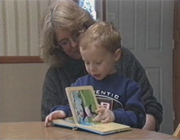
Repetitive Behaviors
One of the three primary areas of dysfunction in autism are problems with repetitive behaviors and restricted interests:
Although children with ASD usually appear physically normal and have good muscle control, odd repetitive motions may set them off from other children. These behaviors might be extreme and highly apparent or more subtle. Some children and older individuals spend a lot of time repeatedly flapping their arms or walking on their toes. Some suddenly freeze in position.
(For additional clips see the ASD Video Glossary.)
As children, they might spend hours lining up their cars and trains in a certain way, rather than using them for pretend play. If someone accidentally moves one of the toys, the child may be tremendously upset. ASD children need, and demand, absolute consistency in their environment. A slight change in any routine—in mealtimes, dressing, taking a bath, going to school at a certain time and by the same route—can be extremely disturbing. Perhaps order and sameness lend some stability in a world of confusion.
Repetitive behavior sometimes takes the form of a persistent, intense preoccupation. For example, the child might be obsessed with learning all about vacuum cleaners, train schedules, or lighthouses. Often there is great interest in numbers, symbols, or science topics.
Play Behavior:
| Age | Type of Play |
| 4-12 mths | Sensorimotor – mouthing, fingering toy without regard to function |
| 12+ mths | Functional play – using toy as it was intended |
| 16+ mths | Symbolic play – giving objects identities other than intended |
| 30+ mths | Imaginative play – pretending without toys or props |
Take a look at a video clip that captures a typically-developing child engaging in pretend play and then a child at-risk for autism who seems completely uninterested in play.
NIMH, AAP

